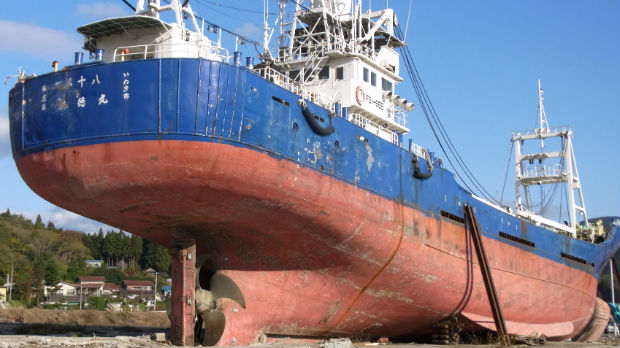Fighting to fish in Japan’s tsunami seas
 Alex Thomson
Chief Correspondent
Alex Thomson
Chief Correspondent
Channel 4 News Chief Correspondent Alex Thomson takes to the seas with Japan’s fishermen whose livelihoods were devastated by the tsunami.
If the area affected by the tsunami in Japan in March was famous for one thing, it simply must be seafood. These are seafaring towns, fishing towns – or they were. And pre-eminent among them is Kesennuma.
You know something unusual is going on here when the town’s main street is dominated by a shark museum. That is, a museum given over to the town’s long history of shark fishing rather than the animals themselves.
But the place was largely destroyed by the tsunami. In particular the town’s lifeblood: the fish quays, packing and seafood processing plants that fringe the now-tranquil harbour.
You know something unusual is giong on here when the town’s main street is dominated by a shark museum.
It reopened in June, which in itself is a spectacular feat – but has never yet regained the kind of output it had prior to the events of that Friday in March.
This morning, the vast holding sheds that line the quayside were completely deserted.

Etsuko Sato, the local manager of a large fishing fleet company told us: “Unless the processing factories who buy the fish can be rebuilt, the amount of fish landed here cannot be anything like before. So that’s our first priority and if that is not achieved Kesennuma will not recover.”
The town became memorable immediately after the tsunami because the deepwater tuna fleet happened to be in harbour. Images of half a dozen 400-tonne vessels randomly left stranded along the town’s harbour side were broadcast globally.
Check out the Channel 4 News interactive map as our team return to Japan
Getting back to sea
As the town was obliterated all around them, the vessels remained silent in a vast wilderness of matchwood shops, houses and offices all around. And there they remained for some three months.
Removing them from the streets, back into the harbour was a multi-million pound operation financed by a complex mixture of insurance companies and fishing co-operatives. But it happened – and relatively swiftly too. Not least, it allowed the town’s road to reopen, previously blocked by these large ocean-going vessels.
But this episode does not have a particularly happy ending. The tuna fleet had undergone such structural trauma in being swept from the Pacific to dry land under violent circumstances that all had to spend many months in dry dock undergoing complete refits. Not all of them escaped the fate of the breaker’s yard.
Nurturing the sea
And here the whole Kesennuma story gets a little delicate. The fact is, before the tsunami these very fish markets and sheds were the target of international criticism and the anger of environmental groups – and it comes back to that shark museum.
It could be that the current disaster provides a fresh, greener start for the fishery here.
Kesennuma was the centre of the shark industry in Japan and you have only to look at the videos often shot secretly here to see this fishery was not exactly sustainable.
Yet it could be that the current disaster provides a fresh, greener start for the fishery here. At the town hall as they plan the vast clear-up from the disaster upstairs, in the lobby there is a notice, a kind of call to arms to the people. It speaks of nurturing the fishery and the ocean, rather than plundering it.
For many here – just getting back to sea would be the main objective – and for many that is a long way off. And without the processing plants functioning here they would not land their catch in the home port anyhow.
Such is the fate of the Shoyo Maru, a deepwater tuna vessel leaving Kesennuma in the morning sunshine today. The good news for locals is that she survived and is back at work – the bad news is that it is doubtful the port could handle her catch at present, wrecked as it is.





